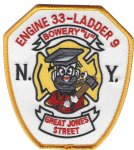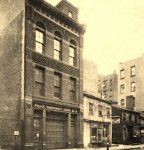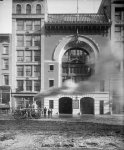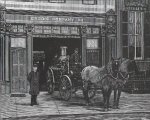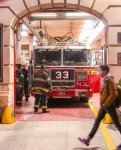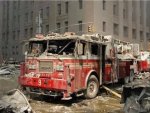You are using an out of date browser. It may not display this or other websites correctly.
You should upgrade or use an alternative browser.
You should upgrade or use an alternative browser.
FDNY and NYC Firehouses and Fire Companies - 2nd Section
- Thread starter mack
- Start date
Engine 33/Ladder 9 firehouse 42 Great Jones Street Bowery/Noho, Manhattan Division 1, Battalion 6 "Bowery U"
Engine 33 organized 220 Mercer Street former volunteer firehouse 1865
Engine 33 new firehouse 15 Great Jones Street 1882
Engine 33 new firehouse 42 Great Jones Street w/Engine 33-2 1899
Engine 33-2 organized 15 Great Jones Street at Engine 33 1883
Engine 33-2 new firehouse 42 Great Jones Street w/Engine 33 1899
Engine 33-2 disbanded 1899
Ladder 9 organized 195 Elizabeth Street former volunteer firehouse 1865
Ladder 9 195 Elizabeth Street renumbered 209 Elizabeth Street 1882
Ladder 9 new firehouse 209 Elizabeth Street 1883
Ladder 9 moved 42 Great Jones Street at Engine 33 1948
Ladder 9 disbanded 1975
Ladder 9 reorganized 42 Great Jones Street at Engine 33 1975)
Ladder 9-2 organized 209 Elizabeth Street at Ladder 9 1883
Ladder 9-2 moved 199 Chrystie Street former volunteer firehouse 1883
Ladder 9-2 disbanded 1889
Battalion 17 organized/located 209 Elizabeth Street at Ladder 9 1903
Battalion 14 located 209 Elizabeth Street at Ladder 9 1903-1904
Battalion 3 located 209 Elizabeth Street at Ladder 9 1904-1904
Rescue 1 organized/located 42 Great Jones Street at Engine 33 1915-1920
Division 1 located 42 Great Jones Street at Engine 33 1961-1974
Battalion 5 located 42 Great Jones Street at Engine 33 1974
Purple K Unit 33 organized 42 Great Jones Street at Engine 33 2007
Engine 33 organized 220 Mercer Street former volunteer firehouse 1865
Engine 33 new firehouse 15 Great Jones Street 1882
Engine 33 new firehouse 42 Great Jones Street w/Engine 33-2 1899
Engine 33-2 organized 15 Great Jones Street at Engine 33 1883
Engine 33-2 new firehouse 42 Great Jones Street w/Engine 33 1899
Engine 33-2 disbanded 1899
Ladder 9 organized 195 Elizabeth Street former volunteer firehouse 1865
Ladder 9 195 Elizabeth Street renumbered 209 Elizabeth Street 1882
Ladder 9 new firehouse 209 Elizabeth Street 1883
Ladder 9 moved 42 Great Jones Street at Engine 33 1948
Ladder 9 disbanded 1975
Ladder 9 reorganized 42 Great Jones Street at Engine 33 1975)
Ladder 9-2 organized 209 Elizabeth Street at Ladder 9 1883
Ladder 9-2 moved 199 Chrystie Street former volunteer firehouse 1883
Ladder 9-2 disbanded 1889
Battalion 17 organized/located 209 Elizabeth Street at Ladder 9 1903
Battalion 14 located 209 Elizabeth Street at Ladder 9 1903-1904
Battalion 3 located 209 Elizabeth Street at Ladder 9 1904-1904
Rescue 1 organized/located 42 Great Jones Street at Engine 33 1915-1920
Division 1 located 42 Great Jones Street at Engine 33 1961-1974
Battalion 5 located 42 Great Jones Street at Engine 33 1974
Purple K Unit 33 organized 42 Great Jones Street at Engine 33 2007
Engine 33/Ladder 9 (continued)
PRE-FDNY VOLUNTEER ERA
ENGINE 4 NIAGARA 220 MERCER STREET
Engine 4 AMERICAN Little Queen St. & Fair St. 1749-1776
Engine 4 AMERICAN John St. 1784-1796
Engine 4 AMERICAN Nassua St. & John St 1800-1802
Engine 4 AMERICAN 23 Chatham St. in the Theater 1802-1802
Engine 4 AMERICAN Chatham St & Nassau St. 1802-1832
Engine 4 AMERICAN 42 Ann St. N. Dutch Church 1832- ?
Engine 4 NIAGARA 33 Great Jones St. 1848 -1853
Engine 4 NIAGARA 220 Mercer St. 1853-865
Engine 4 FDNY organized 220 Mercer Street 1865
ENGINE 4 NIAGARA MEMBERS

ENGINE 4 NIAGARA APPARATUS

PRE-FDNY VOLUNTEER ERA
ENGINE 4 NIAGARA 220 MERCER STREET
Engine 4 AMERICAN Little Queen St. & Fair St. 1749-1776
Engine 4 AMERICAN John St. 1784-1796
Engine 4 AMERICAN Nassua St. & John St 1800-1802
Engine 4 AMERICAN 23 Chatham St. in the Theater 1802-1802
Engine 4 AMERICAN Chatham St & Nassau St. 1802-1832
Engine 4 AMERICAN 42 Ann St. N. Dutch Church 1832- ?
Engine 4 NIAGARA 33 Great Jones St. 1848 -1853
Engine 4 NIAGARA 220 Mercer St. 1853-865
Engine 4 FDNY organized 220 Mercer Street 1865
ENGINE 4 NIAGARA MEMBERS

ENGINE 4 NIAGARA APPARATUS

Last edited:
Engine 33/Ladder 9 (continued)
PRE-FDNY VOLUNTEER ERA
LADDER 18 HIBERNIA 209 ELIZABETH STREET
LADDER 18 HIBERNIAN 270 Mott Street 1860-1864
LADDER 18 HIBERNIAN 195 Elizabeth Street 1864-1865
LADDER 9 FDNY ORGANIZED 209 ELIZABETH STREET 1865
LADDER 18 HIBERNIA MEMBERS

1862 - LADDER 18 HIBERNIA LODD

199 CHRYSTIE STREET FIREHOUSE
ENGINE 30 TOMPKINS 199 Chrystie Street 1830-1841
HOSE 7 WAVE 199 Chrystie Street 1836-1845
LADDER 9-2 FDNY LOCATED 199 CHRYSTIE STREET 1883-1889
PRE-FDNY VOLUNTEER ERA
LADDER 18 HIBERNIA 209 ELIZABETH STREET
LADDER 18 HIBERNIAN 270 Mott Street 1860-1864
LADDER 18 HIBERNIAN 195 Elizabeth Street 1864-1865
LADDER 9 FDNY ORGANIZED 209 ELIZABETH STREET 1865
LADDER 18 HIBERNIA MEMBERS

1862 - LADDER 18 HIBERNIA LODD

199 CHRYSTIE STREET FIREHOUSE
ENGINE 30 TOMPKINS 199 Chrystie Street 1830-1841
HOSE 7 WAVE 199 Chrystie Street 1836-1845
LADDER 9-2 FDNY LOCATED 199 CHRYSTIE STREET 1883-1889
Last edited:
Engine 33/Ladder 9 (continued)
42 Great Jones Street firehouse

Thursday, November 21, 2013
Engine Company 33 -- Nos. 42-44 Great Jones Street
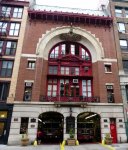
photo by Alice Lum
The collection of sometimes rag-tag volunteer fire companies was consolidated and organized into New York’s professional fire department in 1865. The fire houses were utilitarian structures designed to accommodate vehicles and horses on the ground level and fire fighters on the upper stories. There was little effort at grand design.
But that would all change within a few decades; mostly through the genius of architect Napoleon LeBrun who stepped into the position of the fire department’s main architect in 1879. His sometimes lavish fire houses took the form of Italian palazzos and French chateaux. Having designed over 40 such structures, LeBrun & Sons designed their last fire house in 1895. When the city decided to build a new station for Engine Company No. 33 three years later, architects Ernest Flagg and W. B. Chambers had big shoes to fill.
Engine Company 33 was formed the same year that the Fire Department was organized, and it still operated from its original house on Mercer Street. Now the city planned erect a new station for the Company on plots purchased at Nos. 42 and 44 Great Jones Street. The plans were to incorporate the Fire Chief’s “night headquarters” within the building.
The neighborhood had been, half a century earlier, among the most exclusive residential areas of the city, known as the Bond Street area. Here wealthy citizens with names like Astor and Delano lived in fine Federal-style mansions. By now, however, the upper-class had moved on and the old homes that had not been converted for business purposes housed sometimes less-than-respectable boarders.
In 1897 Mary Norton had died in her home at No. 42 Great Jones Street at just 39 years old. Early that same month, on March 5, May Franklyn who lived next door in No. 44 was shot twice by Philip Metz. The New York Times said May was “described as an actress” and that she “told the police that Philip Metz shot her because he was jealous.”
The two old houses were demolished in 1898 and construction began on the new Engine Company 33 house. By now public buildings were being designed with the City Beautiful Movement in mind—a philosophy that citizens who were surrounded by beautiful, monumental buildings would be prompted to lead lives of social harmony and order. Flagg’s and Chambers’ design would follow the lead.
The building, completed in 1899, was nothing if not monumental. Unlike its earliest predecessors the French Beaux-Arts structure nearly dismissed its utilitarian purpose in favor of flamboyant display. Above the solid limestone base with two bay doors, a grand central arch propelled upward. The concave arch was decorated with a bold, ornate cartouche, and within it three stories of windows were lavished with French-styled railings, a handsome pediment, and balcony. Above it all the deeply-overhanging cornice was supported by wonderful over-sized, paired brackets.
Fantastic paired brackets uphold the overhanging cornice.

photo by Alice Lum
Along with Engine Company 33, Fire Chief Edward F. Crocker moved into the new building. A newspaper reported that his office was decorated with “the usual paintings, statuary, and hunting accoutrements” expected of a high-level official.
The Company received a new steam-powered engine built by the Clapp & Jones Manufacturing Company that could shoot a stream of water 215 feet. The company's vehicles would be pulled by horses for years to come; seemingly fearless animals trained to pull the tenders and engines at break-neck speed through crowded city streets.
On September 28, 1901 the company was responding to a fire at West Broadway and Houston Street, going “at full speed,” according to The New York Times. Workmen had piled stone and brick building materials in the street near the curb near No. 49 West 3rd Street. The tender ran squarely into the pile. “Every man on the tender was thrown to the street,” reported the newspaper. “Fireman E. B. Murphy landed on his face and slid along in the mud, but was not badly hurt.”
When an ambulance arrived, Murphy refused to go to the hospital, preferring instead to join his company responding to the alarm. Chief Croker was on the scene and, although the fire fighter did not go to the hospital, Croker took him back to No 42 Great Jones Street.
The Engine Company's number is incorporated into the elaborate design of the ironwork.

photo by Alice Lum
It was the sort of valiant attitude the chief respected in his men and expected of them. A few years later he would remark “Firemen are going to get killed. When they join the department they face that fact. When a man becomes a fireman his greatest act of bravery has been accomplished. What he does after that is all in the line of work.”
At the turn of the century, gas heating and lighting, poor electrical wiring, flimsy construction techniques and overcrowded tenements were all the ingredients necessary for devastating fires. Alarms of fire sometimes sounded in quick succession. Not all of them, however, were real—but each had to be taken seriously.
On the last day of May in 1902 the men from Engine Company 33 found themselves rushing from one location to another. It started that morning when a man rushed into the fire house reporting a fire in the building at 23 West 4th Street—a six-story business structure. The firemen arrived to find smoke pouring out of the windows. After breaking down the door of the locked building, the men rushed throughout the smoke-filled building looking for the fire.
Finally one of the men went to the cellar where he found that a stove filled with soft coal, banked for the night, was sending out the smoke. There was no fire.
As the firefighters were packing up, a bell began clanging on an upper floor “in a most alarming way,” said The Times. “It sent the firemen scurrying up the stairs, and added to the excitement on the street.” The men had triggered the automatic burglar alarm. They turned on the dampers of the stove and headed back to the fire house.
But they had hardly made it back before another alarm was sounded. They rushed to No. 201 Greene Street where the clothing shop of Silas Whitcup on the fifth floor of the building was in flames. The men struggled with the stubborn fire before finally extinguishing it. Whitcup suffered $2,000 in damages.
The neighborhood around the fire house was filled with garment and millinery factories around this time. The cloth, straw, glues, machine oil and ribbons made good kindling if a fire was sparked. Just five buildings away from Engine Company 33 was the hat-making operation of M. A. Schwartz at No. 30 Great Jones Street in 1906. Next door to Schwartz’s establishment was the Mission House of Father Fitzpatrick where as many as 300 boys and men were fed and sheltered.
Around noon on May 29 there were only about ten girls working in the hat factory, along with Sammy, the son of the proprietor. The Evening World reported that “In the rear of the place is a loft where the supplies are kept. It is very dark and a gas jet is kept burning constantly. Sammy entered the room and climbed up on a pile of big packing boxes to get some chiffon. He was nicely balanced when the boxes caved in and he fell to the floor with a crash. Most of the boxes fell on him.”
Some of the boxes and chiffon fell against the open gas flame and the fabric blazed instantly. Little Sammy got himself out and ran for the door, followed by the ten girls. The Evening World said that the girls “fled, screaming and some of them ran to Engine Company No. 33 a few doors away. Number 33 was out in a second, and as there was a great yellow flame shooting from the windows an alarm was turned in that brought more engines.”
When the firefighters arrived, just minutes after the fire broke out, they were surprised to find a large stream of water “playing through the rear windows. At times it broke through the front and into the street.”
Instead of panicking, the boys from the mission had rushed to the fire hose on the third floor of that building and shot its stream out the window onto the flames in the adjoining building. “Great tongues of fire swept almost in their faces, but they stood their ground pluckily and poured the stream straight into the heart of the white-hot storage room,” said the newspaper.
The quick and brave action of the mission boys held the fire at bay until Engine Company 33 could extinguish it totally.

photo by Alice Lum
Fire stations often drew the admiration and of “buffs” who haunted the streets outside and formed friendships of a sort with the fire crew. The number of “buffs” who gathered outside Engine Company 33 became a problem, since it was also the headquarters of Chief Croker. On Independence Day 1907 the crowd of “buffs” was so great that the fire patrol was called out to disperse them. A few ended up being arrested and some fined.
Insulted, they banded together to form a club. “The ‘buffs’ of Engine Company 33, on Great Jones Street, whose trials and tribulations have recent
recently been aired in the newspapers, are determined that their enemies, who say they have no business making the vicinity of Chief Croker’s night headquarters their congregating place, have determined to form a club, and with this object in view they are going to raffle off a five-dollar gold piece to-night,” reported The New York Times on August 31, 1908. “The proceeds of the raffle will be donated to the renting and equipping of a room where the ‘buffs’ can assemble without fear of police or fire patrol interference.”
One of the “buffs” told the newspaper “we made up our minds to start our own club, with a piano, chairs, and a pinochle deck, and when we get it going the ‘cops’ won’t have a chance to say ‘Move on’ again, so far as we are concerned.”
The men of Engine Company 33, apparently tired of the nuisance, responded to the plans. One of them told a reporter “That piano had better be a well-behaved, quiet instrument, for if it disturbs the sleep of No. 33’s fire-fighters something will be apt to drop.” The journalist added “The fireman did not say whether the object that would get the fall was the piano of the ‘buff’ who is destined to play it.”
When the first alarm was sounded for the fire in the Asch Building on March 25, 1911 it was Engine Company 33 that responded. Upstairs in the building was the Triangle Waist Factory where dozens of women, mostly in their 20s, were trapped by the flames. When firefighters arrived they had difficulty getting near the building due to the number of bodies scattered on the sidewalk—women who had thrown themselves from the windows 9th and 10th floors.
Life nets broke apart with the force of falling bodies and when the fire ladders were extended, they were too short to reach the floors where the victims were trapped. It was all over within thirty horrific minutes; but in the end 146 shirtwaist workers were dead.
Lieutenant George Dunn later testified as a witness in the investigation into the fire, as did Chief Croker. Five weeks after the fire, on May 1, 1911, Edward F. Croker resigned. He was not forced out, nor did he resign out of public humiliation. He explained that he was stepping down after 27 years with the FDNY to devote the rest of his life “to preventing, instead of fighting fires.”
A fire on December 11, 1922 resulted in a heart-warming story for New Yorkers. The fire in the five-story building at No. 52 East 4th Street started on the second floor in the loft occupied by Klein & Sons. It had already established itself before a patrolman noticed the smoke and turned in the alarm. By the time Engine Company 33 arrived shortly before midnight the floor was filled with dense smoke.
Fireman Frank Maixner made his way onto the second floor and groped through the space to get windows open to release the smoke. In the murky darkness he heard the whining of a dog. Feeling his way through the darkness, he located the animal, which was unable to walk, and carried it to safety.
The dog was a brown collie and the firemen immediately named it “Smoky Joe.” The New York Times noted that “A few moments later, however, the name was lengthened to "Smoky Josephine.” The female dog was in great distress from smoke inhalation and after the blaze was under control two firefighters “worked over her and revived her somewhat.” Then the men noticed something else.
“Then it was seen that Josephine was worried over other things. The arrival of junior ‘Smoky Joes’ and ‘Smoky Josephines’ was imminently expected."
Battalion Chief John J. P. Waldron took the pregnant animal to the Hospital of the New York Women’s League for Animals in his personal red automobile. The Times reported that “Brown collie pup mascots are expected to be the style in firehouses in the neighborhood soon.”
In 1948 Ladder Company 9 moved from its old Elizabeth Street house to join Engine Company 33 in the Great Jones fire house. Like Engine Company 33, it had been organized in 1865. Firefighting was still a men-only profession and would stay that way for another thirty years. But after the Fire Department was sued for discrimination in 1979, 41 women were hired in 1982.
The women soon found that being hired did not mean being accepted. One of them was Cecelia O. Salters, the first woman to join Ladder Company 9. She later reported that the men quickly let her know her presence was not appreciated. Although, as she told reporter Evelyn Nieves later, “some shunned her, some made snide comments, others became overprotective.”
Salters toughed it out and when former transit police officer Andre W. Cox joined Engine Company 33 things got a little better for her. Cox said he admired her “grace under pressure” and the two quietly began seeing one another. For two years no one suspected their romance; but when they finally admitted their involvement, they were met mostly with acceptance.
On the evening of July 21, 1990 the couple married—the first New York City firefighters from the same firehouse to do so. Half of the firehouse’s fifty members were present at the wedding.
The firehouse on Great Jones Street was devastated after 14 of its firefighters responded to the attacks on the World Trade Centers on September 11, 2001. One of them was Lieutenant Kevin Pfeifer, whose brother Joseph was a battalion chief. When Engine Company 33 arrived at the disaster the two brothers spotted one another and exchanged a quick word before going in separate directions. It would be the last words they would share.
Kevin Pfeifer died that morning. Of the 14 members of Engine Company 33, only four survived. September 11, 2001 was the darkest day in the history of the Company’s 136-year history.

photo by Alice Lum
The exterior of Flagg’s and Chambers’ monumental fire house is little changed today. It was designated a New York City landmark in 1968; at which time the Landmarks Preservation Commission called it “an exceptionally distinguished public building.”
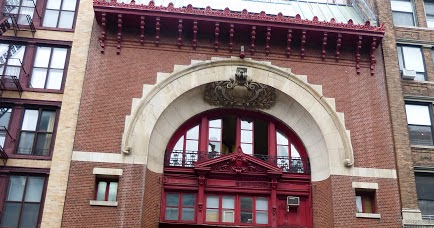
 daytoninmanhattan.blogspot.com
daytoninmanhattan.blogspot.com
42 Great Jones Street firehouse
Thursday, November 21, 2013
Engine Company 33 -- Nos. 42-44 Great Jones Street

photo by Alice Lum
The collection of sometimes rag-tag volunteer fire companies was consolidated and organized into New York’s professional fire department in 1865. The fire houses were utilitarian structures designed to accommodate vehicles and horses on the ground level and fire fighters on the upper stories. There was little effort at grand design.
But that would all change within a few decades; mostly through the genius of architect Napoleon LeBrun who stepped into the position of the fire department’s main architect in 1879. His sometimes lavish fire houses took the form of Italian palazzos and French chateaux. Having designed over 40 such structures, LeBrun & Sons designed their last fire house in 1895. When the city decided to build a new station for Engine Company No. 33 three years later, architects Ernest Flagg and W. B. Chambers had big shoes to fill.
Engine Company 33 was formed the same year that the Fire Department was organized, and it still operated from its original house on Mercer Street. Now the city planned erect a new station for the Company on plots purchased at Nos. 42 and 44 Great Jones Street. The plans were to incorporate the Fire Chief’s “night headquarters” within the building.
The neighborhood had been, half a century earlier, among the most exclusive residential areas of the city, known as the Bond Street area. Here wealthy citizens with names like Astor and Delano lived in fine Federal-style mansions. By now, however, the upper-class had moved on and the old homes that had not been converted for business purposes housed sometimes less-than-respectable boarders.
In 1897 Mary Norton had died in her home at No. 42 Great Jones Street at just 39 years old. Early that same month, on March 5, May Franklyn who lived next door in No. 44 was shot twice by Philip Metz. The New York Times said May was “described as an actress” and that she “told the police that Philip Metz shot her because he was jealous.”
The two old houses were demolished in 1898 and construction began on the new Engine Company 33 house. By now public buildings were being designed with the City Beautiful Movement in mind—a philosophy that citizens who were surrounded by beautiful, monumental buildings would be prompted to lead lives of social harmony and order. Flagg’s and Chambers’ design would follow the lead.
The building, completed in 1899, was nothing if not monumental. Unlike its earliest predecessors the French Beaux-Arts structure nearly dismissed its utilitarian purpose in favor of flamboyant display. Above the solid limestone base with two bay doors, a grand central arch propelled upward. The concave arch was decorated with a bold, ornate cartouche, and within it three stories of windows were lavished with French-styled railings, a handsome pediment, and balcony. Above it all the deeply-overhanging cornice was supported by wonderful over-sized, paired brackets.
Fantastic paired brackets uphold the overhanging cornice.

photo by Alice Lum
Along with Engine Company 33, Fire Chief Edward F. Crocker moved into the new building. A newspaper reported that his office was decorated with “the usual paintings, statuary, and hunting accoutrements” expected of a high-level official.
The Company received a new steam-powered engine built by the Clapp & Jones Manufacturing Company that could shoot a stream of water 215 feet. The company's vehicles would be pulled by horses for years to come; seemingly fearless animals trained to pull the tenders and engines at break-neck speed through crowded city streets.
On September 28, 1901 the company was responding to a fire at West Broadway and Houston Street, going “at full speed,” according to The New York Times. Workmen had piled stone and brick building materials in the street near the curb near No. 49 West 3rd Street. The tender ran squarely into the pile. “Every man on the tender was thrown to the street,” reported the newspaper. “Fireman E. B. Murphy landed on his face and slid along in the mud, but was not badly hurt.”
When an ambulance arrived, Murphy refused to go to the hospital, preferring instead to join his company responding to the alarm. Chief Croker was on the scene and, although the fire fighter did not go to the hospital, Croker took him back to No 42 Great Jones Street.
The Engine Company's number is incorporated into the elaborate design of the ironwork.

photo by Alice Lum
It was the sort of valiant attitude the chief respected in his men and expected of them. A few years later he would remark “Firemen are going to get killed. When they join the department they face that fact. When a man becomes a fireman his greatest act of bravery has been accomplished. What he does after that is all in the line of work.”
At the turn of the century, gas heating and lighting, poor electrical wiring, flimsy construction techniques and overcrowded tenements were all the ingredients necessary for devastating fires. Alarms of fire sometimes sounded in quick succession. Not all of them, however, were real—but each had to be taken seriously.
On the last day of May in 1902 the men from Engine Company 33 found themselves rushing from one location to another. It started that morning when a man rushed into the fire house reporting a fire in the building at 23 West 4th Street—a six-story business structure. The firemen arrived to find smoke pouring out of the windows. After breaking down the door of the locked building, the men rushed throughout the smoke-filled building looking for the fire.
Finally one of the men went to the cellar where he found that a stove filled with soft coal, banked for the night, was sending out the smoke. There was no fire.
As the firefighters were packing up, a bell began clanging on an upper floor “in a most alarming way,” said The Times. “It sent the firemen scurrying up the stairs, and added to the excitement on the street.” The men had triggered the automatic burglar alarm. They turned on the dampers of the stove and headed back to the fire house.
But they had hardly made it back before another alarm was sounded. They rushed to No. 201 Greene Street where the clothing shop of Silas Whitcup on the fifth floor of the building was in flames. The men struggled with the stubborn fire before finally extinguishing it. Whitcup suffered $2,000 in damages.
The neighborhood around the fire house was filled with garment and millinery factories around this time. The cloth, straw, glues, machine oil and ribbons made good kindling if a fire was sparked. Just five buildings away from Engine Company 33 was the hat-making operation of M. A. Schwartz at No. 30 Great Jones Street in 1906. Next door to Schwartz’s establishment was the Mission House of Father Fitzpatrick where as many as 300 boys and men were fed and sheltered.
Around noon on May 29 there were only about ten girls working in the hat factory, along with Sammy, the son of the proprietor. The Evening World reported that “In the rear of the place is a loft where the supplies are kept. It is very dark and a gas jet is kept burning constantly. Sammy entered the room and climbed up on a pile of big packing boxes to get some chiffon. He was nicely balanced when the boxes caved in and he fell to the floor with a crash. Most of the boxes fell on him.”
Some of the boxes and chiffon fell against the open gas flame and the fabric blazed instantly. Little Sammy got himself out and ran for the door, followed by the ten girls. The Evening World said that the girls “fled, screaming and some of them ran to Engine Company No. 33 a few doors away. Number 33 was out in a second, and as there was a great yellow flame shooting from the windows an alarm was turned in that brought more engines.”
When the firefighters arrived, just minutes after the fire broke out, they were surprised to find a large stream of water “playing through the rear windows. At times it broke through the front and into the street.”
Instead of panicking, the boys from the mission had rushed to the fire hose on the third floor of that building and shot its stream out the window onto the flames in the adjoining building. “Great tongues of fire swept almost in their faces, but they stood their ground pluckily and poured the stream straight into the heart of the white-hot storage room,” said the newspaper.
The quick and brave action of the mission boys held the fire at bay until Engine Company 33 could extinguish it totally.

photo by Alice Lum
Fire stations often drew the admiration and of “buffs” who haunted the streets outside and formed friendships of a sort with the fire crew. The number of “buffs” who gathered outside Engine Company 33 became a problem, since it was also the headquarters of Chief Croker. On Independence Day 1907 the crowd of “buffs” was so great that the fire patrol was called out to disperse them. A few ended up being arrested and some fined.
Insulted, they banded together to form a club. “The ‘buffs’ of Engine Company 33, on Great Jones Street, whose trials and tribulations have recent
recently been aired in the newspapers, are determined that their enemies, who say they have no business making the vicinity of Chief Croker’s night headquarters their congregating place, have determined to form a club, and with this object in view they are going to raffle off a five-dollar gold piece to-night,” reported The New York Times on August 31, 1908. “The proceeds of the raffle will be donated to the renting and equipping of a room where the ‘buffs’ can assemble without fear of police or fire patrol interference.”
One of the “buffs” told the newspaper “we made up our minds to start our own club, with a piano, chairs, and a pinochle deck, and when we get it going the ‘cops’ won’t have a chance to say ‘Move on’ again, so far as we are concerned.”
The men of Engine Company 33, apparently tired of the nuisance, responded to the plans. One of them told a reporter “That piano had better be a well-behaved, quiet instrument, for if it disturbs the sleep of No. 33’s fire-fighters something will be apt to drop.” The journalist added “The fireman did not say whether the object that would get the fall was the piano of the ‘buff’ who is destined to play it.”
When the first alarm was sounded for the fire in the Asch Building on March 25, 1911 it was Engine Company 33 that responded. Upstairs in the building was the Triangle Waist Factory where dozens of women, mostly in their 20s, were trapped by the flames. When firefighters arrived they had difficulty getting near the building due to the number of bodies scattered on the sidewalk—women who had thrown themselves from the windows 9th and 10th floors.
Life nets broke apart with the force of falling bodies and when the fire ladders were extended, they were too short to reach the floors where the victims were trapped. It was all over within thirty horrific minutes; but in the end 146 shirtwaist workers were dead.
Lieutenant George Dunn later testified as a witness in the investigation into the fire, as did Chief Croker. Five weeks after the fire, on May 1, 1911, Edward F. Croker resigned. He was not forced out, nor did he resign out of public humiliation. He explained that he was stepping down after 27 years with the FDNY to devote the rest of his life “to preventing, instead of fighting fires.”
A fire on December 11, 1922 resulted in a heart-warming story for New Yorkers. The fire in the five-story building at No. 52 East 4th Street started on the second floor in the loft occupied by Klein & Sons. It had already established itself before a patrolman noticed the smoke and turned in the alarm. By the time Engine Company 33 arrived shortly before midnight the floor was filled with dense smoke.
Fireman Frank Maixner made his way onto the second floor and groped through the space to get windows open to release the smoke. In the murky darkness he heard the whining of a dog. Feeling his way through the darkness, he located the animal, which was unable to walk, and carried it to safety.
The dog was a brown collie and the firemen immediately named it “Smoky Joe.” The New York Times noted that “A few moments later, however, the name was lengthened to "Smoky Josephine.” The female dog was in great distress from smoke inhalation and after the blaze was under control two firefighters “worked over her and revived her somewhat.” Then the men noticed something else.
“Then it was seen that Josephine was worried over other things. The arrival of junior ‘Smoky Joes’ and ‘Smoky Josephines’ was imminently expected."
Battalion Chief John J. P. Waldron took the pregnant animal to the Hospital of the New York Women’s League for Animals in his personal red automobile. The Times reported that “Brown collie pup mascots are expected to be the style in firehouses in the neighborhood soon.”
In 1948 Ladder Company 9 moved from its old Elizabeth Street house to join Engine Company 33 in the Great Jones fire house. Like Engine Company 33, it had been organized in 1865. Firefighting was still a men-only profession and would stay that way for another thirty years. But after the Fire Department was sued for discrimination in 1979, 41 women were hired in 1982.
The women soon found that being hired did not mean being accepted. One of them was Cecelia O. Salters, the first woman to join Ladder Company 9. She later reported that the men quickly let her know her presence was not appreciated. Although, as she told reporter Evelyn Nieves later, “some shunned her, some made snide comments, others became overprotective.”
Salters toughed it out and when former transit police officer Andre W. Cox joined Engine Company 33 things got a little better for her. Cox said he admired her “grace under pressure” and the two quietly began seeing one another. For two years no one suspected their romance; but when they finally admitted their involvement, they were met mostly with acceptance.
On the evening of July 21, 1990 the couple married—the first New York City firefighters from the same firehouse to do so. Half of the firehouse’s fifty members were present at the wedding.
The firehouse on Great Jones Street was devastated after 14 of its firefighters responded to the attacks on the World Trade Centers on September 11, 2001. One of them was Lieutenant Kevin Pfeifer, whose brother Joseph was a battalion chief. When Engine Company 33 arrived at the disaster the two brothers spotted one another and exchanged a quick word before going in separate directions. It would be the last words they would share.
Kevin Pfeifer died that morning. Of the 14 members of Engine Company 33, only four survived. September 11, 2001 was the darkest day in the history of the Company’s 136-year history.

photo by Alice Lum
The exterior of Flagg’s and Chambers’ monumental fire house is little changed today. It was designated a New York City landmark in 1968; at which time the Landmarks Preservation Commission called it “an exceptionally distinguished public building.”
Engine Company 33 -- Nos. 42-44 Great Jones Street
photo by Alice Lum The collection of sometimes rag-tag volunteer fire companies was consolidated and organized into New York’s professio...
Last edited:
Engine 33/Ladder 9 (continued)
42 Great Jones Street firehouse
 FDNY GREAT JONES ENGINE COMPANY 33 LADDER 9
FDNY GREAT JONES ENGINE COMPANY 33 LADDER 9




While strolling along Great Jones Street one day during the summer of 2016, I noticed the fire trucks pulling up to their house, getting ready to enter. I immediately quickened my pace and stood there, gazing inside. One of the firemen approached me and began chatting about the architecture and the history of Engine Company 33 and Ladder Company 9.
I learned from this kind man, who has been with the department since 1983, that the building was designed by renowned architect Ernest Flagg. Pointing to the top of the firehouse, the fireman insisted that I go to my computer and have a look at old photos of the Beaux Arts Singer Building that once stood in lower Manhattan and compare the three-story arch and windows to his firehouse. He assured me that I would see the similarities, for Flagg chose to reuse these concepts when designing his skyscraper. For a short period in 1908, it was considered to be the tallest structure in the world. Sadly, it was knocked down in 1968.
In 1899, the firehouse was originally conceived as a place where the chief of the department could work on a daily basis. Their main headquarters were uptown on 67th Street, but my friendly fireman proudly shared that this was where the highest uniformed person and his staff were housed. At the time, firemen were continuously on duty – “they only had an hour or two off a day until 1917 or 1918 and then it got a little bit better for them.” Thus, it was in this same building that the men ate their meals and slept whenever they could.
I have not met a fireman while walking on the side streets who has not mentioned those who perished on September 11. Tragically, this firehouse lost ten of their fourteen heroic firefighters when the World Trade Center collapsed. At the conclusion of our conversation, this wonderful man told me that he would be “put out to pasture” in less than two years, as there is mandatory retirement at the young age of sixty-five in the fire department. There is no doubt that he will leave having had a full and meaningful career with his peers and that New York City is a better place because of him.
http://sideways.nyc/2012/06/fdny-great-jones-engine-co-33-and-ladder-9/
42 Great Jones Street firehouse




While strolling along Great Jones Street one day during the summer of 2016, I noticed the fire trucks pulling up to their house, getting ready to enter. I immediately quickened my pace and stood there, gazing inside. One of the firemen approached me and began chatting about the architecture and the history of Engine Company 33 and Ladder Company 9.
I learned from this kind man, who has been with the department since 1983, that the building was designed by renowned architect Ernest Flagg. Pointing to the top of the firehouse, the fireman insisted that I go to my computer and have a look at old photos of the Beaux Arts Singer Building that once stood in lower Manhattan and compare the three-story arch and windows to his firehouse. He assured me that I would see the similarities, for Flagg chose to reuse these concepts when designing his skyscraper. For a short period in 1908, it was considered to be the tallest structure in the world. Sadly, it was knocked down in 1968.
In 1899, the firehouse was originally conceived as a place where the chief of the department could work on a daily basis. Their main headquarters were uptown on 67th Street, but my friendly fireman proudly shared that this was where the highest uniformed person and his staff were housed. At the time, firemen were continuously on duty – “they only had an hour or two off a day until 1917 or 1918 and then it got a little bit better for them.” Thus, it was in this same building that the men ate their meals and slept whenever they could.
I have not met a fireman while walking on the side streets who has not mentioned those who perished on September 11. Tragically, this firehouse lost ten of their fourteen heroic firefighters when the World Trade Center collapsed. At the conclusion of our conversation, this wonderful man told me that he would be “put out to pasture” in less than two years, as there is mandatory retirement at the young age of sixty-five in the fire department. There is no doubt that he will leave having had a full and meaningful career with his peers and that New York City is a better place because of him.
http://sideways.nyc/2012/06/fdny-great-jones-engine-co-33-and-ladder-9/
Last edited:
Engine 33/Ladder 9 (continued)
42 Great Jones Street firehouse
 Firehouse Engine Company No. 33
Firehouse Engine Company No. 33
This 1898 firehouse, designed by Ernest Flagg and W.B. Chambers, is a striking example of the French Beaux Arts style of architecture. At the time of construction it was also the headquarters of the Chief of the Fire Department. The colorful and flamboyant design of this otherwise utilitarian structure is particularly appropriate to its function. Its scarlet and gold horse-drawn engines and daring firemen were the envy and admiration of every boy.



https://www.hmdb.org/m.asp?m=24424
42 Great Jones Street firehouse
This 1898 firehouse, designed by Ernest Flagg and W.B. Chambers, is a striking example of the French Beaux Arts style of architecture. At the time of construction it was also the headquarters of the Chief of the Fire Department. The colorful and flamboyant design of this otherwise utilitarian structure is particularly appropriate to its function. Its scarlet and gold horse-drawn engines and daring firemen were the envy and admiration of every boy.



https://www.hmdb.org/m.asp?m=24424

